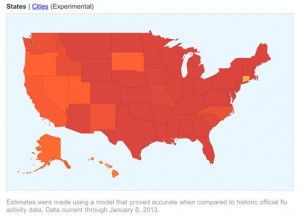Health News – For all of you who know how Google trends works this should be an alarming stat. Google trends measures the number of times a certain term in searched in google. Flu Symptoms is being searched at an all time high.
 If you ask the Centers for Disease Control and Prevention in Atlanta, this year’s flu season is looking “moderately severe.” That assessment has been reflected in the relatively calm tone of national media coverage in recent weeks.
If you ask the Centers for Disease Control and Prevention in Atlanta, this year’s flu season is looking “moderately severe.” That assessment has been reflected in the relatively calm tone of national media coverage in recent weeks.
But wait—if you ask Google Flu Trends, we’re in the midst of an outbreak that is shaping up to be the most extensive on record. Never before this week have so many people searched for the terms that Google believes are likely indicators of the influenza virus. If Google’s algorithm is accurate, that should translate to a volume of doctor visits that significantly exceeds that of the H1N1 outbreak in October 2009. The media usually loves a good health scare. So why isn’t anyone sounding the alarm?
Because, four years after Google Flu Trends launched, the CDC still drives the bulk of national media coverage, suggesting that health reporters aren’t fully comfortable putting stock in Internet algorithms that go back only a few years. Yet Google’s figures may deserve far more attention than they’ve been getting.
By the CDC’s latest “outpatient surveillance” estimates, roughly 5.6 percent of Americans visiting the doctor are reporting respiratory illnesses, or flu-like symptoms. That’s a large number, significantly higher than the national baseline of 2.2 percent or the 2.3 percent peak of last year’s mild flu season. But it’s not entirely out of the ordinary. The figure approached 6 percent in the moderately severe 2007-2008 season and topped out at 7.7 percent in October 2009 in the midst of the H1N1 pandemic.
But here’s the thing: The CDC’s current estimates aren’t all that current. Because they are based on after-the-fact reports from more than 3,000 health care providers around the country, the numbers can tell us only how many people were suffering from the flu a couple weeks ago. Today’s CDC FluView figures, for instance, come from the week of Dec. 23. We  won’t know until Friday how many people visited the doctor with respiratory symptoms during the week that began on Dec. 30.
won’t know until Friday how many people visited the doctor with respiratory symptoms during the week that began on Dec. 30.
That’s where Google comes in. In fall 2008, the company’s charitable arm, Google.org, unveiled Flu Trends, a site that scans millions of Google searches from around the world to track flu activity in near real time. According to a study published in Nature in February 2009, the system can detect outbreaks nearly two weeks before they show up in the official CDC reports. And the site can tell you on any given day what countries, states, and even cities are likely seeing the largest number of cases.
Today, Flu Trends is painting a foreboding picture. On a global scale of green (minimal flu activity) to bright red (intense flu activity), the United States is the reddest country in the world. Zoom in, and the red stretches are almost unbroken across the country’s eastern two-thirds. (Hang in there, Connecticut!) Boston, New York, Philadelphia, Houston, and Denver are among a slew of cities tagged with the “intense” rating.
But the really ominous chart is the one that shows the trend line for the nation as a whole. It roughly agrees with the CDC that flu activity in December was about in line with the “moderately severe” peak in 2007-2008. But if Google is right, the CDC’s snapshot came just as the outbreak was gaining steam. Since mid-December, the trend line has rocketed past that of all previous years and now towers over that of the October 2009 H1N1 pinnacle, suggesting a CDC outpatient surveillance figure of an unprecedented 8.9 percent.
Is the CDC and the government covering up something?
By Will Oremus, slate.com

